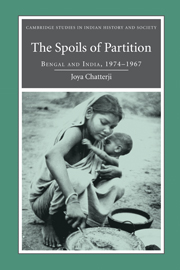Book contents
- Frontmatter
- Contents
- List of maps and illustration
- List of tables
- List of abbreviations
- Glossary
- Preface and acknowledgements
- Introduction
- Part I Hopes and fears
- Part II The Bengal diaspora
- 3 Partition and migration: refugees in West Bengal, 1947–1967
- 4 Staying on: partition and West Bengal's Muslim minorities
- Part III The politics of a partitioned state
- Conclusion
- Appendix
- Bibliography
- Index
3 - Partition and migration: refugees in West Bengal, 1947–1967
Published online by Cambridge University Press: 25 June 2009
- Frontmatter
- Contents
- List of maps and illustration
- List of tables
- List of abbreviations
- Glossary
- Preface and acknowledgements
- Introduction
- Part I Hopes and fears
- Part II The Bengal diaspora
- 3 Partition and migration: refugees in West Bengal, 1947–1967
- 4 Staying on: partition and West Bengal's Muslim minorities
- Part III The politics of a partitioned state
- Conclusion
- Appendix
- Bibliography
- Index
Summary
Building new nations, as one commentator has observed, is a ‘refugee-generating process’. Efforts to create homogeneous nation states change some subjects into minorities who find themselves on the ‘wrong’ side of new borders or in the ‘wrong’ state, with the ‘wrong’ ethnicity, language or religion. Minorities are made to feel they should belong somewhere else, that they should be ‘nationals’ of some other new state made up of ‘people like them’. New nations tend to leave large numbers of people stranded in countries they can no longer call their own, with the choice of having to seek refuge somewhere else or to remain where they are as second-class citizens. Many are forced across frontiers and become refugees or asylum-seekers in other nations. In the aftermath of empire, such migrations have profoundly transformed the demographic landscapes of the modern world.
The partition of the sub-continent into India and Pakistan on the basis of a religious divide is a classic example of this process. It left millions of Hindus, Sikhs and Muslims on the ‘wrong’ side of the fence and led to an exodus unparalleled in history. Between August and December 1947, 15 million people crossed the western borders between India and Pakistan in both directions and in roughly equal numbers. Many millions of Hindus crossed India's eastern borders with Pakistan into the new state of West Bengal and into Assam and Tripura.
- Type
- Chapter
- Information
- The Spoils of PartitionBengal and India, 1947–1967, pp. 105 - 158Publisher: Cambridge University PressPrint publication year: 2007
- 2
- Cited by

